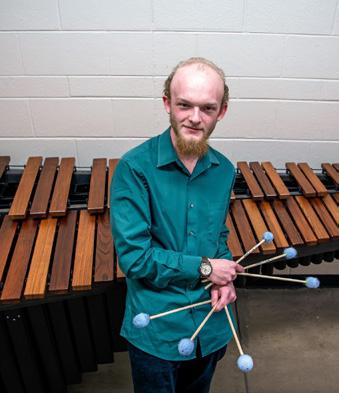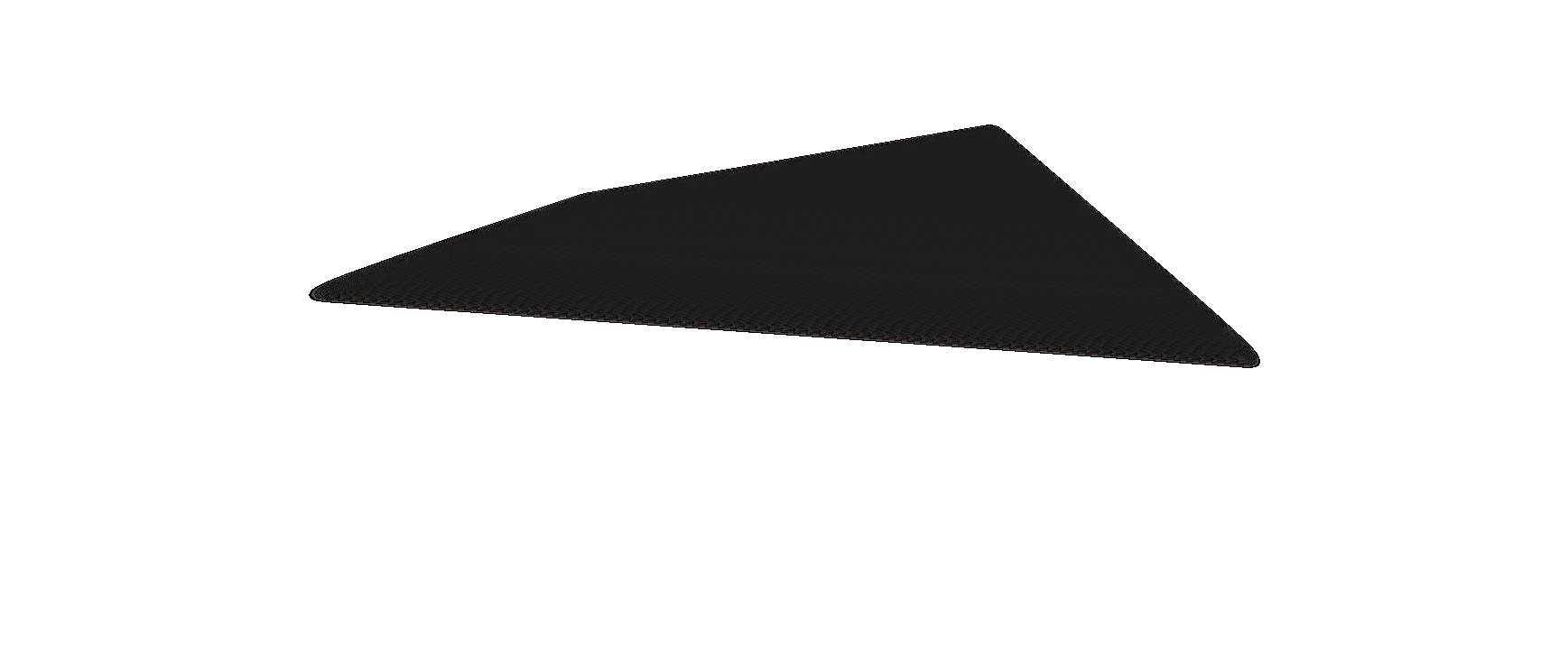Propulsion!
MAY 2, 2024, 7:30 P.M. | GRIFFEN CONCERT HALL
DR.RACHELWADDELL, Music Director and Conductor
ROBERTSTAHLY, Assistant Conductor
Short Ride in a Fast Machine
Program:
Prism Rhapsody for Marimba and Orchestra
Quinn Harlow, Marimba
Adams (b. 1947)
Keiko Abe (b. 1937)
Menuet Pour orchestra d’archets
Robert Stahly, Conductor
Ricardo Castro (1864-1907)
Danzón No. 2
Arturo Márquez (b.1950)
SYMPHONY ORCHESTRA
UNIVERSITY
John
Flute
Jenna Moore, principal*
Lucy McCrossan
Ella Patterson, piccolo
Madrigal Frederick-Law (piccolo 2 on Adams)
Oboe
Madina Rashidova, co-principal
Sarah Veldhuizen, co-principal
Clarinet
Alfredo Ramirez, principal
Andrew Rutten*
Bradley Irwin (honorary)
Katrina Whitenect
Claire Cunnigham
Bassoon
Charlie Beauregard, co-principal
James Scott, co-principal*
Shane Underwood
Kaitlin Moses, Contrabassoon
Horn
Jacob Andersen, principal
Sophia Marino
Rachel Richardson*
Erin Wilson
Trumpet
Kris Usrey
Dylan Crabill
Bryce Wicks
John Pirillo
Trombone
Christian Heck*
Andre Ranis
Shae Mitchell*
Tuba
Carson Ross
Timpani and Percussion
Colin Ferry, principal
Quinn Harlow
Cameron Becker
Taylor Smith*
Jarred Premo*
Piano
Otto Huffman
Harp
Alaina Bongers
Violin 1
Jessica Rosado, concertmaster*
Cesar Reyes
Russell Wolfe
Kirby Miller
Isabel Ulate*
Hallie Harris
Chelsea Smith
Violin 2
Annie Smith, principal*
Kathryn Carlos
Lamarana Balde
Grace Marsh-Wood
Melissa Kelley
Katelyn Gould
Hanna Recker
Armando Villa-Ignacio
Ryan Thompson
Viola
Ethan Buell, principal*
Shawn Murphy
Percy Slovut
Charlie Wootton
Madison Ramonette
Emily Rowe
Laurel Wettstein
Cello
Avery Smith, principal*
Laurel Ave*
Isaac Dinsmore
Matt Fox
Kristin Weninger*
Lillian Rogers
Mae Ferry
Bass
Cristian Mazo, principal*
Max Williams
Max Johnson*
Thomas Hasler*
Nick Hailey
Alison Podgorski
Librarians
Rob Stahly, head librarian
Lamarana Balde
Avery Smith
PROGRAM NOTES
Short Ride in a Fast Machine
John Adams (b. 1947)
The most famous American fanfare is Hail to the Chief. Next comes Aaron Copland’s thumping huff and puff in honor of the “the Common Man.” Most fanfares are brilliant, some even aggressive (etymologists disagree whether the word “fanfare” is onomatopoetic or actually connected with the verbal family that gives us “fanfaronade,” meaning blustering and bragging behavior), though John Adams has also explored the possibilities of the restrained and pianissimo fanfare (in his Tromba lontana).
Short Ride in a Fast Machine is a joyfully exuberant piece, brilliantly scored for a large orchestra. The steady marking of a beat is typical of Adams’ music. Short Ride begins with a marking of quarter notes (woodblock, soon joined by the four trumpets) and eighths (clarinets and synthesizers); the woodblock is fortissimo and the other instruments play forte. Adams sees the rest of the orchestra as running the gauntlet through that rhythmic tunnel. About the title: “You know how it is when someone asks you to ride in a terrific sports car, and then you wish you hadn’t?”
Short Ride in a Fast Machine features the usual minimalist earmarks: repetition, steady beat, and, perhaps most crucially, a harmonic language with an emphasis on consonance unlike anything in Western art music in the last 500 years. Adams is not a simple – or simpleminded – artist. His concern has been to invent music at once familiar and subtle. For all of their minimalist features, works such as Harmonium, Harmonielehre, and El Dorado are full of surprises, always enchanting in the glow and gleam of their sonority, and bursting with the energy generated by their harmonic movement.
— Michael Steinberg (from The John Adams Reader)
Prism Rhapsody for Marimba and Orchestra
Keiko Abe (b. 1937)
Prism Rhapsody premiered on April 18, 1996, in Umeå, Sweden with the Umeå Symphony under conductor Arvo Volmer, with Keiko Abe (the composer) as soloist. The fifteen-minute work is characterized by two parts with a cadenza in the middle. The orchestra frequently plays the melodic line, often incorporating rhythmic ideas and motives introduced by the marimba. In addition to Prism Rhapsody, Abe also composed Prism Rhapsody II for two marimbas and wind band and a version for solo marimba and piano.
— Program Notes by Rachel Waddell
Menuet Pour orchestra d’archets
Ricardo Castro Herrera (7 February 1864 in Durango, Mexico – 27 November 1907 Mexico City, Mexico)
Concert pianist and composer, Ricardo Castro was born to Vicente, a deputy congressman, and Maria de Jesus. His family encouraged participation in the arts, starting Ricardo on piano at an early age. After moving to Mexico City, Ricardo was enrolled in the National Conservatory of Music where he finished the program in 5 years instead of the usual 10, graduating at age 19. Around this time he also completed his First Symphony in C Minor. Castro then went to Europe on a scholarship from the Mexican Government from 1903 to 1906. While most of his works were for piano, he is often credited with composing the first Mexican cello concerto and the first Mexican piano concerto. His music contains the chromatic harmonies of Europe but remains true to its Mexican roots.
Menuet for String Orchestra is composed in a European Minuet and Trio style. A charming melody starts the piece in G major. The harmonies quickly evolve through minor modes and related keys through colorful chromaticism, characteristic of the late Romantic time period. The Trio section moves the tonic to C major with longer soaring melodies. After the Trio the work returns to the original Menuet melodies to conclude the composition.
— Program Notes by Rob Stahly
Danzón No. 2
Arturo Márquez (b.1950)
Danzón No. 2 was commissioned in 1994 by the National Autonomous University of Mexico and has come to serve as a pseudo second national anthem of Mexico. It is the second of nine danzónes by Arturo Márquez that blends traditional and modern elements of Mexican classical music. The danzón evolved from the Cuban contradance or habanera. Written in duple meter, it is a slow, formal partner dance featuring syncopation, instrumental pauses, and call and response. This particular work features solos by the clarinet, oboe, piano, violin, trumpet, and piccolo. It was made popular by the Simón Bolívar Youth Orchestra, under the direction of Gustavo Dudamel.
— Program Notes by Rachel Waddell
The CSU Symphony Orchestra wishes to thank:
Mike Solo
Valerie Reed, Peter Muller, and their Team
Jennifer Clary
Nicole Darling
Jim Doser
Charles Beauregard
Ethan Urtz
Rob Stahly
COLORADO STATE UNIVERSITY MUSIC APPLIED FACULTY
Violin
Ron Francois
Viola
Margaret Miller
Cello
Romina Monsanto
Bass
Forest Greenough
Guitar
Jeff Laquatra
Flute
Ysmael Reyes
Michelle Stanley
Oboe
Pablo Hernandez
Clarinet
Wesley Ferreira
Sergei Vassiliev
Saxophone
Peter Sommer
Dan Goble
Bassoon
Cayla Bellamy
Trumpet
Stanley Curtis
Horn
John McGuire
Trombone
Drew Leslie
Tuba/Euphonium
Stephen Dombrowski
Percussion
Eric Hollenbeck
Shilo Stroman
Harp
Kathryn Harms
Piano
Bryan Wallick
Tim Burns
Organ
Joel Bacon
Voice
Nicole Asel
Tiffany Blake
John Lindsey

QUINN HARLOW was born in Fredericksburg, Virginia in 2004 and moved to Colorado in 2008. They fell in love with drumming at a young age by playing Rock Band 2 and would spend countless hours trying to beat their high score. In fifth grade, they received the opportunity to play real percussion instruments, which they eagerly accepted. In middle school, they began to develop a passion for mallet percussion instruments, especially the marimba. They honed their skills in high school via marching band, concert band, jazz band, and orchestra. Starting at the age of 16, they began touring the country as a mallet player. They are an undergraduate music performance major and will graduate in Spring 2026.

Conductor ROBERT STAHLY passionately furthers orchestral music through programs that reimagine classical works alongside engaging new and underperformed works. Mr. Stahly made his debut conducting Copland’s “The Tender Land” in the Spring of 2023 at Colorado State University. His most recent recital was a celebration of contemporary music featuring five living composers. He also conducted portions of Mozart’s “The Marriage of Figaro” and “Symphony No. 33” in performance at the CCM Opera Bootcamp. Perpetually studying his craft, Mr. Stahly additionally participated in conducting workshops at the Eastman School of Music, Bard College, University of Missouri Kansas City, and University of Colorado. His conducting teachers include Harold Farberman, Gianmaria Griglio, Mark Gibson, Apo Hsu, Neil Varon, Kevin Noe, Gary Lewis, Wes Kenney, and Dr. Rachel Waddell.
Mr. Stahly is the Apprentice Conductor for the Fort Collins Symphony, the Conductor of the Denver Young Artists Orchestra String Ensemble and former Conductor of the Longmont Youth Symphony String Ensemble. Active as a performer, he is the former Associate Principal Cellist with the Longmont Symphony Orchestra and is the cellist for the Elevation String Quartet. A conductor who is passionate about music education, Mr. Stahly continues to visit school music programs to coach new generations of musicians and teachers. During his 13 years at Longmont High School Mr. Stahly tripled the size of the orchestra program while at the same time increasing the quality and diversity of the ensembles. In 2016, he was recognized as one of the top six educators in the St. Vrain Valley School District with an “Encore Award” and in 2019 he was a finalist for “Teacher of the Year.” Mr. Stahly received Bachelor’s Degrees in Music Education, Tuba Performance, and a String Pedagogy Certificate from Colorado State University in 2008. In 2022 he returned to CSU to pursue a Master’s Degree in Orchestral Conducting.

With energy, imagination, and a passion for people, American conductor RACHEL WADDELL proves an unabashed advocate for the 21st century orchestra. Her leadership across the country demonstrates her innate ability to transform vision into action. Rachel believes by uplifting, celebrating, and reflecting the artistry of our neighbors, orchestras become the creative heartbeat of our communities. Through breathtaking collaborations and an untiring dedication to education, mentorship, and community, Rachel inspires transformative experiences and ensembles.
Rachel serves as the newly appointed Director of Orchestras at Colorado State University. Previously she was the Director of Orchestral Activities and Assistant Professor with the Arthur Satz Department of Music at the University of Rochester in New York. The UR Orchestras gained recognition as a two-time national winner for the American Prize’s Vytautas Marijosius Memorial Award in Orchestral Programming in 2019 and 2020. In 2021, they won international acclaim in collaboration with conducting colleague Tiffany Chang and Oberlin Conservatory through a digital performance of Beethoven’s Choral Fantasy, named Best Instrumental Performance of 2021 by the LIT Talent Awards.
Rachel maintains a busy profile in the professional and academic worlds. She has conducted orchestras around the world including the Orchestre Métropolitain, the Rochester, Las Vegas, and Fort Wayne Philharmonics, the Southwest Michigan Symphony Orchestra (where she was a Music Director Finalist) and Cleveland’s Suburban Symphony. While serving as the Associate Conductor of the Canton Symphony Orchestra in Ohio, Rachel conducted over 80 performances of classical, pops, and education concerts. She has attended numerous conducting programs including the Dallas Opera’s prestigious Hart Institute for Women Conductors, and Mark Shapiro’s Conducting Intensive at Juilliard. In August 2022 she made her Vienna debut conducting Così fan tutte as part of the Vienna Opera Academy. In July 2023 she made her Canadian debut with the Orchestre Métropolitain, after being selected to conduct by Yannick Nézet-Séguin at Le Domaine Forget de Charlevoix.
Rachel’s interest in the constantly evolving role and responsibility of orchestras within their communities led her to co-found Conductors for Change, Inc., a 501(c)(3) for anyone reimagining the future of the American orchestra.
Rachel holds a DMA in Orchestra Conducting from the University of Nevada, Las Vegas, and a certificate in Music Industry Essentials from the prestigious Clive Davis Institute of Recorded Music at NYU’s Tisch School of the Arts.


MAY 5, 6 P.M.
CSUARTSTICKETS.COM
GRIFFIN CONCERT
HALL
THE SCHOOL OF MUSIC, THEATRE, AND DANCE PRESENTS
DIRECTED BY ERIC HOLLENBECK












